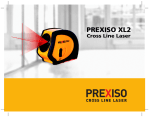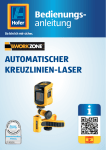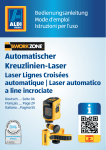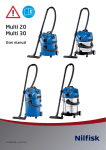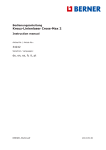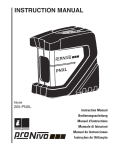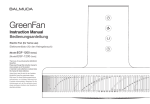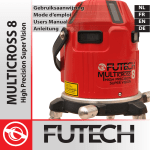Download User Manual Cross Line Laser
Transcript
CL30-110x120.qxp 9/04/09 23:29 Page 1 User Manual Cross Line Laser PAGE 1 PAGE 8 PÁGINA 15 SEITE 22 PAGINA 29 CL30-110x120.qxp 9/04/09 23:29 Page 2 Applications • • • • • • Floor and wall tiles Wallpaper Finish carpentry Door and window frames Drop ceilings Interior decoration… Recommended use Leveling accuracy Self-leveling range Laser beams Cross line Manual mode Power Working temperature Tripod mount Size Weight Includes Battery life Overview Control panel Laser output window Battery compartment (under rubber over-mold) A 1/4” x 20 tripod mount B 2 Specifications Leveling 100 ft. (30 m) ± 1/8” @ 30’ (3 mm / 9 m) ± 4° Highly visible 635 nm, Class 2 M 130° horizontal and vertical fan angles Lock line to match any angle between two points 3 AA batteries 1,5 V 23° to 104° F (-5° to +40°C) 1/4’’ x 20 thread 3-1/2” x 3-1/4" x 2-1/2” (9 x 8,4 x 6,2 cm) 12 oz (340 g) Belt carrying pouch, batteries 25 hrs. continuous use (1 line on), 12.5 hrs. continuous use (2 lines on) Self-leveling GB F E D LED indications • The LED is green in automatic mode. • If the LED is red and the lasers blink in level or plumb mode, the laser is out of leveling range. • If the LED is green and the lasers blink in cross line mode, the laser is out of leveling range. • The LED is red in manual mode. • If the LED blinks, the batteries are low. 3 CL30-110x120.qxp 9/04/09 23:29 Page 4 Calibration control Control panel 1. a. b. c. d. e. ON button. Press to cycle through A-E: Level (horizontal fan line) Plumb (vertical fan line) Cross line (horizontal and vertical) Locked cross line (manual mode) Off 2. LED for laser mode, low battery USING THE CL30 The CL30 cross line laser uses a pendulum mechanism for self-leveling. In order for the unit to automatically level, it must be set up within 4 degrees of level. Care and Handling This is a precision instrument which must be handled with care. Avoid shock and vibrations. Keep the laser and aperture lens clean and dry. Use a soft cloth and glass cleaner to clean them. Remove batteries before long-term storage. Safety • Do not stare directly at the beam. • Do not set up the laser at eye level. We recommend checking the instrument’s calibration before initial use; then periodically to ensure proper reference. Checking the horizontal line front to back 1. Set up the CL30 about 6” (15 cm) away from a wall (Surface 1) and 1215 ft. (4-5m) from another wall (Surface 2). 2. Turn it on in cross line mode. Be sure it's self-leveling. 3. Carefully mark the center where the lines cross on Surface 1. This is A1. 4. Rotate the laser 180° and mark the center where the lines cross on Surface 2 (this is B1). 5. Right illustration: Move the laser 6” away from Surface 2 and mark the center where the lines cross on Surface 2 (this is B2). 6. Rotate the laser 180° and mark the center where the lines cross on Surface 1 (this is A2). 7. Measure the distance between A1 and A2, and also between B1 and B2. If the distances are the same, the laser is in calibration. If the difference between the two sets of marks is greater than 1/8” (3 mm), the laser is out of calibration. GB F E D A B COMPLIES WITH 21 CFR 1040.10 AND 1040.11 EXCEPT FOR DEVIATIONS PURSUANT TO LASER NOTICE NO. 50 DATED JULY 26, 2001 AGATEC, 2202 Redmond Road Jacksonville, AR 72076 4 5 CL30-110x120.qxp 9/04/09 23:29 Page 6 Warranty Checking the horizontal line side to side 1. Set the instrument up approximately 8’ (2.5m) from a wall that is at least 16’ (5m) long. 2. Project the laser cross 1’ (30cm) from one corner (1). Mark point (2) along the horizontal laser line 8’ (2.5m) from the intersection of the laser cross. 3. Rotate the instrument so that the laser cross (3) is projected at the wall 15’ (4.6m) away from the first laser cross point (1). 4. The deviation of the horizontal laser line from the point (2) marked previously should not be further apart than 1/8” or 3 mm. The CL30 laser is guaranteed to be free of manufacturing defects for a period of 2 years (in North America, one year, with warranty to two years with online or mail-in registration within 45 days of purchase). Any abnormal usage or if the instrument has been subjected to shock will void this warranty. Under no circumstances will the liability of the manufacturer exceed the cost of repairing or replacing the instrument. Disassembling the instrument by other than qualified and certified technicians will void this warranty. Specifications are subject to change without notice. GB F E D Information For more information, please contact 6 For US, Canada and Latin America For all other countries AGATEC Construction Lasers 2202 Redmond Rd., Jacksonville, AR 72076 - USA Tel. (800) 643-9696 (501) 982-4433 Fax (501) 982-0880 [email protected] www.agatec-na.com AGATEC 21 boulevard Littré 78600 Le Mesnil-le-Roi France Tél. +33 (0) 1 34 93 35 80 Fax +33 (0) 1 34 93 35 89 [email protected] www.agatec.com 7 CL30-110x120.qxp 9/04/09 23:29 Page 8 Applications • • • • • • • Sol, Cloison, Tapisserie, Finitions de menuiserie, Agencement, Huisserie, plafond suspendu, Décoration intérieure… GB F E D Manuel d’utilisation Laser Croix Description Clavier de commande Fenêtre de sortie des faisceaux Compartiment à piles (situé sous la protection en gomme) A 8 9 CL30-110x120.qxp 9/04/09 23:29 Page 10 Spécifications Portée Précision Plage de compensation Faisceau laser Laser croix Mode manuel 30 m ±3 mm à 9 m ± 4° 635 nm, visible, Classe 2M 130° de largeur d’angle horizontal et vertical Verrouillage de la ligne pour s'aligner sur un angle entre deux points Alimentation 3 piles AA alcalines 1,5V Température de fonctionnement -5° à +40°C Filetage 1/4’’ x 20 Dimensions 9 x 8,4 x 6,2 cm Poids 340 g Inclus Etui de ceinture, support aimanté, piles Autonomie 25 h en continu pour 1 faisceau, 12h50 en continu pour 2 faisceaux Mise à niveau automatique Clavier de commande 1. Bouton Marche. Appuyer sur celui-ci pour naviguer des fonctions A à E : a. Mode horizontal b. Mode vertical c. Mode croix d. Utilisation en mode manuel (hors calage automatique) : faisceaux horizontal et vertical e. Arrêt du laser 2. Diode UTILISATION DU CL30 Le laser Croix CL30 utilise un pendule pour sa mise à niveau automatique. Afin que le laser puisse se mettre à niveau automatiquement, il doit être installé à un maximum de 4 degrés du niveau horizontal. GB F E D Entretien et recommandations Le CL30 est un instrument de précision qui doit être manipulé avec précaution et soin. Eviter le plus possible les chocs et les vibrations. Conservez le sec et propre. Conserver la lentille de sortie du laser propre. La nettoyer avec un chiffon doux et du nettoyant pour vitre. Otez les piles quand vous ne vous servez pas du laser pendant une longue période. Diode • La diode est verte en mode automatique. • Si la diode est rouge et que le faisceau clignote en mode horizontal ou vertical, le laser n’est pas dans sa plage de compensation. • Si la diode est verte et que le laser clignote en mode croix, le laser n’est pas dans sa plage de compensation. • La diode est rouge en mode manuel. • Si la diode clignote, les batteries sont déchargées. 10 Sécurité • Ne pas fixer directement le rayon. • Ne pas installer le rayon à la A hauteur des yeux. 11 CL30-110x120.qxp 9/04/09 23:29 Page 12 Vérifier le calibrage de votre CL30 Nous vous recommandons de vérifier le calibrage de votre appareil avant sa première utilisation ; puis de le vérifier périodiquement. Vérification du niveau horizontal d’avant en arrière 1. Positionner votre CL30 à 15 cm d’un mur (Surface 1) et à 4-5 m d’un autre mur (Surface 2). 2. Mettre le laser en marche en mode croix. S’assurer que le laser est dans sa plage de nivellement. 3. Marquer alors minutieusement la position du point de croisement des deux lignes sur la Surface 1. Il s’agit du point A1. 4. Faire pivoter le laser de 180°. Marquer également la position du point de croisement des deux lignes sur la Surface 2. Il s’agit du point B1. 5. Illustration de droite : Installer le CL30 à 15 cm de la Surface 2 et marquer la position du point de croisement des deux lignes sur la Surface 2. Il s’agit du point B2. 6. Faire pivoter le laser de 180°. Marquer également la position du point de croisement des deux lignes sur la Surface 1. Il s’agit du point A2. 7. Mesurer la distance entre A1 et A2 ainsi qu’entre B1 et B2. Si les distances sont les même, le laser est calibré. Si la différence entre les deux jeux de marques est supérieure à 3mm, le laser n’est pas calibré. 12 Vérification du niveau horizontal d’un côté à l’autre 1. Positionner votre CL30 à 2,5 m d’un mur long d’au moins 5m. 2. Projeter les faisceaux en mode croix à 30 cm d’un coin (1). Marquer le point (2) le long de la ligne horizontale du laser à 2,5 m de l’intersection de la croix du laser. 3. Faire pivoter le laser de sorte que la croix (3) soit projetée sur le mur à 4,6 m du premier point (1) de rencontre de la croix. 4. L’écart entre la ligne horizontale du laser et le point (2) marqué précédemment ne doit pas être supérieur à 3 mm. GB F E D 13 CL30-110x120.qxp 9/04/09 23:29 Page 14 Garantie Votre CL30 est garanti contre tous défauts de fabrication et ce, pour une période de 2 ans (1 an pour l'Amérique du Nord, la garantie est étendue à 2 ans si le produit est enregistré sur internet ou par courrier dans les 45 jours suivant l'achat). Un mauvais usage de l’appareil, un usage anormal ou un choc entraînerait automatiquement la nullité de la garantie. En aucun cas, la responsabilité du fabricant n’excéderait le coût de réparation ou de remplacement de l’appareil. Le démontage du CL30 par des personnes autres que des techniciens formés et agréés entraînerait une annulation de la garantie. Les spécifications sont susceptibles de changer sans préavis. GB F E D Manual de utilización Cross Line Láser Renseignements Pour tout renseignement contactez 14 Pour les USA, le Canada et les pays d’Amérique Latine Pour tous les autres pays AGATEC Construction Lasers 2202 Redmond Rd., Jacksonville, AR 72076 - USA Tel. (800) 643-9696 (501) 982-4433 Fax (501) 982-0880 [email protected] www.agatec-na.com AGATEC 21 boulevard Littré 78600 Le Mesnil-le-Roi France Tél. +33 (0) 1 34 93 35 80 Fax +33 (0) 1 34 93 35 89 [email protected] www.agatec.com 15 CL30-110x120.qxp 9/04/09 23:29 Page 16 Applicacions • • • • • • • Suelo Tabique Tapiz Carpintería Arreglo Marco, sobre techo Interiorismo… Características Alcance Precisión Nivelación Diodo laser Rayo Pilas Temperatura de uso Fileteado Dimensiones Peso Incluye Tipo de nivelación Hasta 30m (100 ft.) ±3 mm a 9 m (1/8” a 30’) ± 4° 635 nm, visible, Clase 2M 130° de amplitud horizontal y vertical 3 pilas AA alcalinas 1,5V -5° hasta +40°C (23° hasta 104° F) 1/4’’ x 20 9 x 8,4 x 6,2 cm (3-1/2" x 3-1/4" x 2-1/2") 340 g (12 oz) 25 h en continuo para 1 línea, 12h50 en continuo para 2 líneas Automática GB F E D Descripción Teclado Ventana de salida del rayo Compartimento para pilas (debajo de la protección) A Diodo • El diodo está verde en modo automático. • Si el diodo está rojo y si el rayo está parpadeando en modo horizontal o vertical, el láser no está en su zona de compensación. • El diodo está rojo en modo manual. • Si el diodo está parpadeando, significa que las pilas están descargadas. Fileteado 16 17 CL30-110x120.qxp 9/04/09 23:29 Page 18 Teclado Control de calibración 1. Botón ON. Empujar ese botón para navegar desde la función A hasta E : a. Modo horizontal b. Modo vertical c. Modo cruz d. Modo manual (sin auto nivelación) : línea horizontal y vertical. e. Apagar el láser Utilización del CL30 El láser de línea CL30 utiliza un péndulo para su auto nivelación. Para que la auto nivelación se haga, el láser tiene que estar instalado a máximum 4 grados del nivel horizontal. 2. Diodo Recomendaciones El CL30 es un instrumento de medida que tiene que estar usado con cuidado. Evitar lo más posible los choques y las vibraciones. Conservarlo bien seco y limpio. Conservar la lente del láser bien limpio. Limpiarla con algo suave y limpiador para cristal. Sacar las pilas cuando no use el láser durante un periodo largo. Le recomendamos verificar la calibración de su instrumento antes de usarlo por primera vez y luego periódicamente para asegurarse de la referencia correcta. Verificación de la línea horizontal de adelante hacia atrás 1. Colocar el CL30 a 15cm (6”) de una pared (superficie 1) y a 4-5m (1215 ft.) de otra (superficie 2). 2. Encender el CL30 en modo cruzado. Asegurarse que este auto nivelado. 3. Marcar el centro de la cruz en la superficie 1 (A1). 4. Girar el CL30 de 180° y marcar el centro de la cruz en superficie 2 (B1). 5. Dibujo a la derecha: colocar el CL30 a 15cm (6") de la superficie 2 y marcar la posición de la cruz (B2). 6. Girar el CL30 de 180°. Marcar también la cruz de las 2 líneas de superficie 1 (A2). 7. Medir la distancia entre A1 y A2 así que entre B1 y B2. Si las distancias son iguales, el láser esta calibrado. Si la diferencia entre los 2 conjuntos de marcas supera los 3mm (1/8"), la calibración del láser no está correcta. GB F E D Seguridad • No mirar fijamente el rayo. • No instalar el láser al nivel de los ojos. 18 A 19 CL30-110x120.qxp 9/04/09 23:29 Page 20 Garantía Verificación de la línea horizontal de un lado a otro 1. Colocar el CL30 a 2,5m (8') de una pared larga de mínimo 5m (16'). 2. Encender el CL30 en modo cruzado a 30cm (1') de una esquina (1). Marcar el punto (2) a lo largo de la línea horizontal del láser a 2,5m (8') de la intersección de la cruz del láser. 3. Girar el láser de tal manera que la cruz (3) sea visible en la pared a 4,6m (15') del primer punto (1) de encuentro con la cruz del láser. 4. La distancia entre la línea horizontal del láser y el punto (2) no tiene que superar 3mm (1/8"). Su CL30 está garantizado contra todos defectos de fabricación para un periodo de 2 años (En Norte América, un año, y hasta 2 años con una inscripción en el internet hasta 45 días después de la compra). Un mal uso del aparato o un choque significaría automáticamente la anulación de la garantía. En ningún caso, la responsabilidad del fabricante superaría el coste de reparación o de reemplazo del equipo. El desmontaje del CL30 por otras personas que técnicos formados o agradados significaría una anulación de la garantía. Las especificaciones pueden cambiar sin preaviso. GB F E D Informaciones Para todas informaciones contacte 20 Para los USA, el Canada y América Latina Para todos los otros países AGATEC Construction Lasers 2202 Redmond Rd., Jacksonville, AR 72076 - USA Tel. (800) 643-9696 (501) 982-4433 Fax (501) 982-0880 [email protected] www.agatec-na.com AGATEC 21 boulevard Littré 78600 Le Mesnil-le-Roi France Tel. +33 (0) 1 34 93 35 80 Fax +33 (0) 1 34 93 35 89 [email protected] www.agatec.com 21 CL30-110x120.qxp 9/04/09 23:29 Page 22 Anwendungen • • • • • • Boden- und Wandfliesen Tapeten Zimmerarbeiten Tür- und Fensterrahmen Abgehängte Decken Inneneinrichtungen... GB F E D Bedienungsanleitung Kreuz-Linien-Laser Übersicht Bedienfeld Laser Austrittsfenster Batteriefach (unter Gummiüberzug) A 1/4" x 20 Stativanschluss 22 23 CL30-110x120.qxp 9/04/09 23:29 Page 24 Spezifikationen Empfohlener Einsatz Nivelliergenauigkeit Selbstnivellierbereich Laserstrahlen Laserkreuz Manueller Modus Stromversorgung Betriebstemperatur Stativanschluss Grösse Gewicht Zubehör Nivellierung 30 m ±3 mm auf 9 m ± 4° Gut sichtbar 635nm, Laserklasse 2M 130° horizontaler und vertikaler Fächerwinkel Laserlinie blockieren um jeden Winkel zwischen zwei Punkten zu erstellen 3 AA Batterien 1,5 V -5° bis +40°C 1/4" x 20 Gewinde 9 x 8.4 x 6.2 cm 340 g Gürteltasche, Batterien Selbstnivellierend LED Anzeigen • Die LED ist grün im automatischen Modus • Ist die LED rot und der Laserstrahl blinkt im Nivellier- oder Lot-Modus, dann ist der Laser außerhalb des Selbstnivellierbereichs • Ist die LED grün und der Laserstrahl blinkt im Kreuzlinienmodus, dann ist der Laser außerhalb des Selbstnivellierbereichs • Die LED ist rot im manuellen Modus • Blinkt die LED, sind die Batterien fast leer 24 Bedienfeld 1. EIN Schalter. Drücken um durch A-E zu schalten: a. Nivellieren (horizontale Linie) b. Loten (vertikale Linie) c. Kreuzlaser (horizontal und vertikal) d. Arretierte Kreuzlinie (manueller Modus) e. AUS 2. LED für den Lasermodus, niedriger Batteriestand Gebrauch des CL30 Der CL30 Kreuzlinienlaser benutzt einen Pendelmechanismus zur Selbstnivellierung. Zur Funktion der Selbstnivellierung muss das Gerät innerhalb 4° zur Horizontalen aufgebaut werden. GB F E D Gebrauch und Pflege Dies ist ein Präzisionsinstrument welches mit Sorgfalt behandelt werden muss. Vermeiden Sie Schläge und Vibrationen. Halten Sie den Laser und die Austrittslinse sauber und trocken. Benutzen Sie ein weiches Tuch sowie einen Glasreiniger zur Reinigung der Austrittslinse. Entfernen Sie die Batterien vor einer längeren Lagerung. Sicherheit • Nicht direkt in den Strahl blicken. • Nicht den Laser auf Augenhöhe aufbauen. A 25 CL30-110x120.qxp 9/04/09 23:29 Page 26 Überprüfung der Justierung Wir empfehlen die Justierung des Gerätes vor dem erstmaligen Gebrauch zu überprüfen; anschliessend in regelmässigen Abständen. Überprüfung der horizontalen Linie von vorne nach hinten 1. Bauen Sie den CL30 ca. 15cm (Fläche 1) bzw. 4-5m (Fläche 2) zwischen zwei Wänden auf. 2. Schalten Sie ihn ein und aktivieren Sie den Kreuzlinien Modus mit aktivierter Selbstnivellierung. 3. Markieren Sie möglichst genau das Kreuzlinien Zentrum an Fläche 1. Dies ist A1. 4. Rotieren Sie den Laser um 180° und markieren Sie das Kreuzlinien Zentrum an Fläche 2. Dies ist B1. 5. Rechte Zeichnung: Bewegen Sie den Laser ca. 15cm weg von Fläche 2 und markieren Sie das Kreuzlinien Zentrum an Fläche 2. Dies ist B2. 6. Rotieren Sie den Laser um 180° und markieren Sie das Kreuzlinien Zentrum an Fläche 1. Dies ist A2. 7. Messen Sie den Abstand zwischen A1 und A2 und zwischen B1 und B2. Sind die Abstände identisch, ist der Laser einwandfrei justiert. Sollte der Abstand zwischen den beiden Markierungen mehr als 3mm sein, so ist der Laser nicht mehr korrekt justiert. 26 Überprüfung der horizontalen Linie von links nach rechts 1. Bauen Sie das Gerät ca. 2,5m entfernt von einer Wand auf, die min. 5m breit ist. 2. Projizieren Sie das Laserkreuz 30cm von der einer Ecke entfernt (1). Markieren Sie den Punkt (2) entlang der horizontalen Laserlinie 2,5m vom Kreuzungspunkt des Laserkreuzes entfernt. 3. Rotieren Sie das Gerät so, daß das Laserkreuz (3) 4,7m entfernt vom ersten Laserkreuz (1) an der Wand projiziert wird. 4. Die Abweichung der horizontalen Laserlinie von dem vorher markierten Punkt (2) sollte nicht grösser als 3mm sein. GB F E D 27 CL30-110x120.qxp 9/04/09 23:29 Page 28 Garantie Der CL30 Laser hat eine Werksgarantie von zwei (2) Jahren (in Nordamerika ein (1) Jahr, bzw. zwei (2) Jahre bei online oder postalischer Registration innerhalb von 45 Tagen nach Kauf). Jeder abweichender Gebrauch oder das Aussetzen des Gerätes durch Schlag oder Vibrationen setzt diese Garantie aus. Unter keinen Umständen wird die Haftbarkeit des Herstellers die Kosten einer Reparatur oder Austauschs des Gerätes überschreiten. Die Demontage des Instruments von anderen als qualifizierten oder zertifizierten Technikern setzt diese Garantie aus. Technische Änderungen ohne Vorankündigungen jederzeit vorbehalten. GB F E D Manuale d'uso Livella laser a croce Informationen Für mehr Informationen kontaktieren Sie bitte 28 Für USA, Canada und Lateinamerika Für alle anderen Lânder AGATEC Construction Lasers 2202 Redmond Rd., Jacksonville, AR 72076 - USA Tel. (800) 643-9696 (501) 982-4433 Fax (501) 982-0880 [email protected] www.agatec-na.com AGATEC 21 boulevard Littré 78600 Le Mesnil-le-Roi France Tel. +33 (0) 1 34 93 35 80 Fax +33 (0) 1 34 93 35 89 [email protected] www.agatec.com 29 CL30-110x120.qxp 9/04/09 23:29 Page 30 Applicazioni • Piastrelle per pavimenti e rivestimenti • Carta da parati • Finiture in legno • Infissi per porte e finestre • Controsoffitti • Decorazioni d'interni, ecc. Raggio d’azione Precisione Campo di autolivellamento Raggi laser Linea a croce Modalità manuale Desscrizione Pannello di controllo Finestra di uscita laser Vano batterie (situato sotto il rivestimento in gomma) A 1/4” x 20 attacco per treppiede 30 Dati tecnici 30 m ± 3 mm a 9 m ± 4° 635 nm, alta visibilità, Classe 2 M Angoli di emissione 130° orizzontale e verticale Bloccaggio della linea per allinearsi ad un angolo tra due punti Alimentazione 3 batterie AA da 1,5V Temperatura d'esercizio da -5° a +40°C Attacco per treppiede filettatura 1/4’’ x 20 Dimensioni 9 x 8,4 x 6,2 cm Peso 340g Fornito con custodia con cinghia per il trasporto, batterie Durata delle batterie 25 ore di uso continuo (1 linea attiva) 12 ore e mezzo di uso continuo (2 linee attive) Livellamento Automatico GB F E D Spie LED • Spia LED verde in modalità automatica. • Se la spia LED è rossa e i raggi laser lampeggiano in modalità livellamento o allineamento a piombo, l'apparecchio è fuori dal campo di livellamento. • Se la spia LED è verde e i laser lampeggiano in modalità linea a croce, l'apparecchio è fuori dal campo di livellamento. • La spia LED è rossa in modalità manuale. • Se la spia LED lampeggia, le batterie sono scariche. 31 CL30-110x120.qxp 9/04/09 23:29 Page 32 Pannello di controllo 1. Tasto ON. Premere per passare dalla funzione A alla E: a. Livellamento (raggio orizzontale) b. Allineamento a piombo (raggio verticale) c. Linea a croce (orizzontale e verticale) d. Linea a croce bloccata (modalità manuale) e. Off 2. Spia LED per modalità laser, batterie scariche Verifica della calibratura Utilizzo dell’apparecchio CL30 Grazie ad un sistema a pendolo, la livella laser a croce CL30 si orienta automaticamente. Per fare in modo che il livellamento venga effettuato automaticamente, è necessario che l'apparecchio si trovi all'interno del campo di livellamento di 4 gradi. Norme di sicurezza • Non fissare mai direttamente il raggio laser • Non dirigere mai il raggio all’altezza 32 A È consigliabile controllare la calibratura dell'apparecchio prima di usarlo per la prima volta. In seguito ripetere periodicamente il controllo per garantirne la precisione. Verifica del livellamento orizzontale fronte-retro 1. Collocare l'apparecchio CL30 a circa 15 cm da una parete (Superficie 1) e a 4-5 m da un'altra parete (Superficie 2). 2. Attivare la modalità linea a croce. Assicurarsi che si trovi in fase di autolivellamento. 3. Contrassegnare accuratamente il centro del raggio all’incrocio delle linee sulla Superficie 1 (Punto A1). 4. Ruotare l'apparecchio laser di 180° e contrassegnare il centro del raggio all’incrocio delle linee sulla Superficie 2 (Punto B1). 5. Figura di destra: Posizionare l'apparecchio laser a 15 cm dalla Superficie 2 e contrassegnare il centro del raggio all’incrocio delle linee sulla Superficie 2 (Punto B2). 6. Ruotare l'apparecchio laser di 180° e contrassegnare il centro del raggio all’incrocio delle linee sulla Superficie 1 (Punto A2). 7. Misurare la distanza tra i punti A1 e A2 e tra B1 e B2. Se le distanze sono uguali, l'apparecchio laser è calibrato correttamente. Se invece la differenza tra le due coppie di punti è superiore a 3 mm, l'apparecchio laser non è calibrato correttamente. GB F E D 33 CL30-110x120.qxp 9/04/09 23:29 Page 34 Cura e manutenzione Verifica del livellamento orizzontale da lato a lato 1. Posizionare l'apparecchio a circa 2,5 m da una parete di almeno 5 m di lunghezza. 2. Proiettare la croce laser a 30 cm da un angolo (1). Contrassegnare il punto (2) lungo il raggio laser orizzontale a 2,5 m dall'intersezione della croce laser. 3. Ruotare l'apparecchio in modo che la croce laser (3) venga proiettata sulla parete a 4,6 m di distanza dal punto contrassegnato per la prima croce laser (1). 4. La distanza tra il raggio laser orizzontale e il punto (2) precedentemente contrassegnato non deve essere superiore a 3 mm. Il prodotto è uno strumento di precisione e va maneggiato con attenzione. Evitare urti e vibrazioni. Tenere l’apparecchio laser e la lente di apertura sempre puliti e asciutti. Per la pulizia utilizzare un panno morbido e detergente per vetri. Rimuovere le batterie se lo strumento non viene usato per un periodo prolungato. GB F E D Garanzia La garanzia dell’apparecchio laser CL30 è valida per 2 anni dalla data di acquisto (in Nord America, un anno, con garanzia di due anni o con la linea-mail di registrazione entro 45 giorni dalla data di acquisto). Durante questo periodo sono coperti tutti i vizi di fabbricazione. Sono esclusi dalla garanzia i danni dovuti ad uso improprio e ad urti subiti dallo strumento. In nessun caso il produttore sarà responsabile in misura superiore al costo di riparazione o di sostituzione dello strumento. La garanzia decade in caso di interventi da parte di centri di assistenza non autorizzati e non competenti. Dati tecnici soggetti a modifica senza obbligo di notifica. Informazioni Per tutte informazioni si mette in contatto con Per gli Stati Uniti, Per tutti gli altri paesi Canada e America Latina AGATEC AGATEC Construction Lasers - 2202 Redmond Rd., 21 boulevard Littré Jacksonville, AR 72076 - USA 78600 Le Mesnil-le-Roi - France Tel. (800) 643-9696 - (501) 982-4433 Tél. +33 (0) 1 34 93 35 80 Fax (501) 982-0880 Fax +33 (0) 1 34 93 35 89 [email protected] - www.agatec-na.com [email protected] - www.agatec.com 34 35 CL30-110x120.qxp 9/04/09 23:29 Page 36 CL30 - 2009-03 Your dealer/Votre revendeur/Su revendedor/Ihr Händler/Vostro rivenditore




















